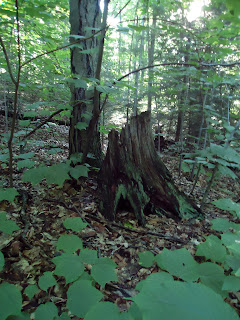Published in the January 13th issue of Tompkins Weekly (download free PDF copy here)
WHY ACTIVE FOREST MANAGEMENT MATTERS
Many
people assume that the role forests play in combating climate change is simple;
just leave the trees, and they’ll grow and store carbon as they mature. While
the idea of keeping land forested is important to sequestering more carbon, the
rate of carbon storage a forest is drastically affected by the management choices
that farmers and landowners engage in. And in fact, there is good evidence that
sustainably managed forests may offer more climate benefits than those left
unmanaged.
In
a report issued last fall, the Society of American Foresters offered the
insights of an extensive review of more than 280 recent studies of forest
carbon relationships and noted that, “Young, healthy forests are carbon sinks.
As forests mature, they generally become carbon-cycle neutral or even carbon
emission sources…decline varies but generally occurs in the first 100–150 years
as tree mortality losses increase.”
Many
of our local forests are under 100 years old, often the young regrowth
resulting from the widespread abandonment of farmland over the last century.
Forest cover in Tompkins County was around 19% percent in 1900, but the
widespread abandonment of farmland has increased cover to over 60% today.
But
this trend won’t last forever. As forests get older, the pattern shifts from
growth to decay, which releases carbon. Since much of the forestland is first
generation, active management is needed to maintain a diversity of ages,
balancing the benefits of mature trees with the vigor of new growth. Spreading
the harvest of trees over a longer timeframe and supporting regeneration of
young seedlings ensures forests can continue to be good sequesters of carbon.
 |
| American Chestnut stump from civil war era |
Age
is but one factor in the equation. Forest health is another key element. Trees
that are overcrowded, diseased, or stressed from other factors do not grow as
rapidly as those that are given ample sunlight and moisture. Thinning out
weaker trees has the effect of giving the healthiest trees an opportunity to grow
faster and absorb even greater amounts of carbon.
Relieving
stressors in the forest also means that outbreaks of pests and diseases are
less likely to wipe out a forest, which rapidly increases carbon release to the
atmosphere. As a recent report by the Intergovernmental Panel on ClimateChanges states, “Sustainable management practices keep forests growing
at a higher rate over a potentially longer period of time, thus providing net
sequestration benefits…”
To be successful, management
opportunities need to be diverse. Current incentives for managing forests
revolve mostly around timber harvesting, which often dramatically impacts the
forest by removing many of the older and healthier trees that should be left to
re-seed the next generation. More
localized, small scale, and economical drivers need development to encourage
more people to get into the woods and manage for long-term health.
Agroforestry practices provide real
potential to involve farmers and foresters in a cooperative effort to engage in
good management while growing crops for a multitude of income streams. Of these
practices, two in particular are being promoted as promising new forms of
agriculture: silvopasture and forest farming.
Silvopasture combines forestry
(Silvo means “forest”) with rotational grazing of livestock, which benefits the
trees, the animals, and the farmer. The practice including thinning appropriate
forests to about a 50% canopy cover and growing native perennial grasses in the
understory, which are grazed by animals and then allowed a rest period. (see previous blog post)
The resulting system provides a
sustainable source of meat in the short-term and also can yield a multitude of
wood products including firewood, timber, mushroom logs, fenceposts, etc.
Alternatively, nut trees could be planted for a food yield. Good rotational
grazing practices have also shown to bolster carbon sequestration in soil,
which means this system could be an incredible carbon sink.
Forest farming is a practice of
cultivating forest crops such as mushrooms, medicinal plants, and fruits under
an existing forest canopy. Of these practices, the most developed in the
Northeast United States is cultivation of edible mushrooms, most notably
shiitake. Trees thinned out to improve forest health are inoculated with
mushroom spawn and each log yields 8 to 10 pounds of mushrooms over its
lifetime, with each pound fetching $10 - $12. (more: Mushroom classes and Mushroom CSA)
Systems like the above mentioned
give farmers and landowners direct incentive to manage their forests and thus support carbon sequestration, along with numerous other benefits that forests
provide, including regulating temperature and wind flows, providing habitat for
many species, and preventing soil erosion. A sustainable future land use must
include tree-based systems as a way to counteract climate change.
Steve Gabriel grew up in Tompkins County and has had a
lifelong interest in forests. He currently promotes agroforestry practices through
Work With Nature, LLC, where the mission is to design and develop
forest-based agriculture systems to preserve and enhance northeastern forests
and support farm economy. He can be reached at www.workwithnaturedesign.com,
where sources for this article may be found.



